स्वास्थ्य और स्वाद से भरपूर मशरूम के मूल्य संवर्धित उत्पाद
Mushrooms are an edible fungus typically grown above the soil. Mushrooms grow at temperatures ranging 15 - 23 0c. There are different types of mushrooms like milky mushrooms, White button mushroom, Crimino Mushroom, Portabello Mushroom, Shiitake Mushroom, Maitake Mushroom, Oyster Mushroom, Enoki Mushroom, Beech Mushroom, Black Trumpet Mushroom, King Trumpet Mushroom, Chanterelle Mushroom, Hedgehog Mushroom, Morel Mushroom, Porcino Mushroom. The three majorly grown mushrooms in India are button mushrooms, milky mushrooms, oyster mushrooms.
Mushrooms are nutritious, medicinal and functional food. It is considered as a health food as it contains low calories, high protein, dietary fiber, vitamins, and minerals (Barros et al., 2008). Mushrooms are nutritionally desirable because of their low energy value, fiber content, and high antioxidant capacity (Kalac, 2013).
According to reports of Cheung 2010 different species of mushroom contains different amount of carbohydrates which usually ranges between 35- 70%, including digestible and non-digestible carbohydrates.
The protein content ranges from 1.6 -2.1 g/100g (Mattila et al., 2002). According to Sadler (2003), mushrooms are a good source of insoluble fiber in the form of chitin (polymer of N-acetyl-glucosamine) and non-starch polysaccharides like β-glucans. Mainly mushrooms are low in fat and a good source of unsaturated fatty acids, 75% (w/w) of the total fatty acidsas per reports of Andre et al. (2010).
Mushrooms are a good source of vitamins and minerals, particularly thiamine, riboflavin, niacin, biotin, pantothenic acid, Folic acid, vitamin B12, calcium, magnesium, sodium, potassium, phosphorus, copper, iron, manganese and zinc (Cheung, 2008 and Bhal, 1989). Therefore, mushrooms are considered as an excellent food source to alleviate malnutrition in developing countries (Pathmashini, 2008).
Types of mushroom
Mostly four types of mushroom are grown commercially in India.
- White button mushroom (Agaricusbisporus).
- Oyster mushroom (Pleurotus spp.).
- Milky mushroom (Calocybeindica).
- Paddy straw mushroom (Volvariellavolvacea).
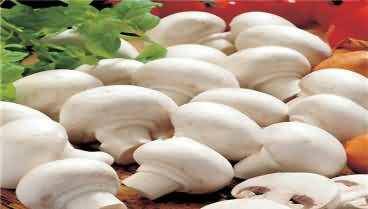 |
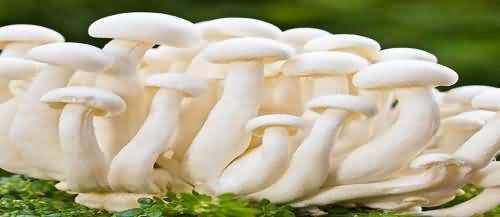 |
| White button mushroom | Milky mushroom |
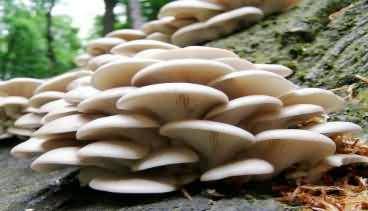 |
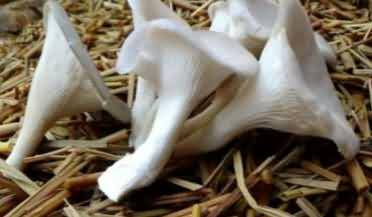 |
| Oyster mushroom | Paddy straw mushroom |
Nutritional value of mushroom
Protein - Most mushrooms have a high protein content, usually around 20-30% by dry weight.
Fibber - Helps lower cholesterol and is important for the digestive system.
Vitamin D - Essential for the absorption of calcium.
Copper - Aids in helping the body absorb oxygen and create red blood cells.
Selenium - An antioxidant that helps neutralize free radicals, thus preventing cell damage and reducing the risk of cancer and other diseases. Mushrooms contain more selenium than any other form of produce.
Potassium - An extremely important mineral that regulates blood pressure and keeps cells functioning properly.
Other important minerals - Such as phosphorous, zinc, and magnesium.
Benefits of value addition
- Easy to use.
- Prevent Losses, Avoid glut.
- Transported easily.
- Generate Employment.
- Better utilization of resources.
- Longer shelf life.
- Export purpose.
- Increase profit.
Value Added Products of Mushrooms
1. Mushroom preserves (Murabba)
Murabba (preserve) is made from button mushrooms, by cooking it whole or in the form of pieces in heavy sugar syrup, till it becomes tender and transparent. In murabba preparation, around 45% of button mushrooms are used for every 55% of sugar and cooking is continued till a concentration of at least 68% of soluble solid is reached.
1.1 Procedure
- Fresh button mushrooms are graded, washed, pricked and blanched in 0.05% KMS solution for 10 min.
- It is treated with 40% of its weight of sugar daily for 3 days.
- Then, mushrooms are taken out from the syrup and 0.1% citric acid and remaining 40% of sugar is mixed in the syrup.
- After bringing its concentration to 65ºBrix, mushrooms are added in the syrup and good quality murabba is prepared.
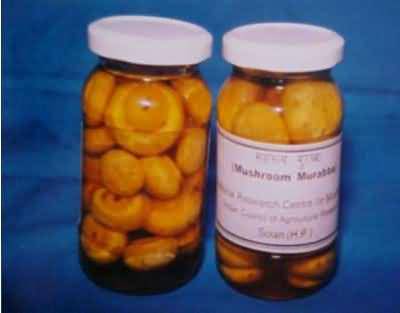 Mushroom murabba
Mushroom murabba
2. Mushroom soup powder
- Soups are commonly used as appetizers but also as main course by the diet-conscious.
- Using quality mushroom powder produced from the button mushroom and oyster mushroom dried in the dehumidifying air cabinet-drier.
- Dried button mushroom slices or whole oyster mushrooms are finely ground in a pulveriser and passed through 0.5 mm sieve.
- Mushroom soup powder is prepared by mixing this powder with milk power, corn flour and other ingredients.
- This has to be mixed with equal quantity of water for the preparation of good quality mushroom soup with characteristic aroma and taste
Ingredients for mushroom soup powder
Mushroom powder - 16
Corn flour - 5
Milk powder - 50
Refined oil - 4
Salt - 10
Cumin powder - 2
Black pepper - 2
Sugar - 10
Ajinomoto - 2


Mushroom soup powder
3. Mushroom biscuit
Delicious and crunchy mushroom biscuits can prepare by using the Button or Oyster mushroom powder and various ingredients. For making biscuits entire ingredients are finely ground using electric mixture and cleaned with the help of fine sieve separately.
The ingredients viz., ghee and sugar are well mixed for 5-7 minutes using Dough kneader to make the mixture homogenous. The various ingredients required for preparation of delicious and crunchy mushroom biscuits. The ingredient like sugar gives desired sweetness, ghee gives smoothness and ammonium bicarbonate gives the crunchiness to the biscuits.
3.1 Ingredients for mushroom biscuits
Ingredients Parts (g)
- Maida - 40
- Sugar powder - 18
- Bakery ghee - 15
- mushroom powder - 15
- Salt - 6
- Coconut powder - 3
- Glucose/Fructose - 5
- Baking powder - 6
- Ammonium bicarbonate - 35
- Milk powder - 4
3.2 Procedure
- These ingredients are first added to dough kneader for dry mixing of 20-25 minutes.
- Then water was added to kneader to make dough cohesive and homogenous and mixing continued for next 10-15 minutes.
- After that dough was kept for 30 minutes under the wet cloths to make it cool.
- Then thin sheets of dough (1.25 cm thick or required shape)were made and cut into different shapes of biscuits using different steel dies.
- These raw cut biscuits were kept in the steel trays in systematic manner and then these trays were shifted to hot oven(212 °C) for baking purpose.
- After 15 minutes, baking trays are removed from the hot oven and cooled, the biscuits were ready for packaging and or for serving.
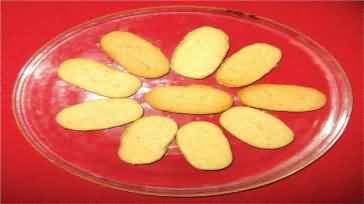
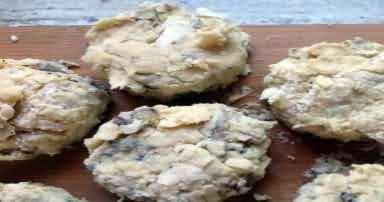 Mushroom biscuits
Mushroom biscuits
4. Mushroom ketch-up
Ketch-up is a common and popular product relished for its typical taste and texture as accompaniment with snacks. It is made by concentrating the juice / pulp of the fruits / vegetables without seeds and pieces of skin, as the skin and seed spoil the appearance of the ketch-up. It does not flow freely and is highly viscous in nature. They also contain more of sugar and less of acid.
4.1 Ingredients for mushroom Ketchup-
Ingredients Parts (%)
Salt - 10
Sugar - 25
Acetic acid - 1.5
Sodium benzoate - 0.065
Onion - 10
Garlic - 0.5
Ginger - 3
Cumin - 1
Black pepper - 0.1
Red chilly powder - 1
Ajinomoto - 0.2
Arrarote - 0.2
4.2 Procedure
- Freshly harvested button mushrooms are washed, sliced and cooked in 50 percent of water for 20 min.
- Mushroom paste is prepared using a mixer grinder.
- The various ingredients required for the preparation of mushroom ketchup are listed ABOVE.
- Ingredients are mixed in the paste and cooked to bring its TSS to 35ºBrix.
- Then the ketch-up is filled in the sterilized bottles or jars.
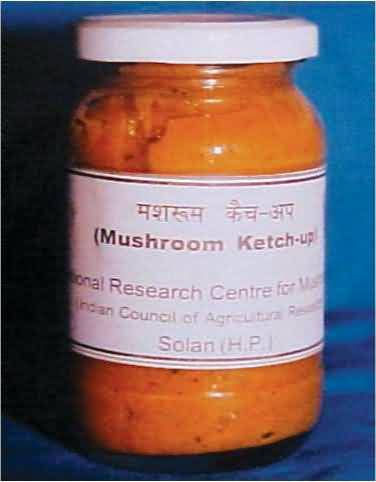 Mushroom ketch-up
Mushroom ketch-up
5. Mushroom chips:-
- The freshly harvested button mushrooms are washed, sliced (2 mm) and blanched in 2 % brine solution.
- The mushrooms are dipped overnight in a solution of 0.1 % of citric acid + 1.5 % of NaCl + 0.3 % of red chilly powder.
- After draining off the solution, the mushrooms are subjected to drying in cabinet dryer at 60 ºC for 8 h.
- Then it is fried in the refined oil and good quality chips are prepared.
- Garam masala and other spices can be spread over the chips to enhance the taste.
- After spices mixing, the chips are packed in polypropylene packets and sealed after proper labelling.
6. Mushroom Pickling
Pickling is a method of long-term storage to preserve mushrooms in an economically viable way. These pickles are good appetizers as well as they add palatability to the meal. It is also a process by which one can store to relish them during the off-season when the price of mushrooms is very high.
6.1 Ingredients for mushroom Pickle
Ingredients g/kg
Black mustard seed powder - 35
Turmeric powder - 20
Red chili powder - 10
Cumin seed powder - 1.5
Fennel seed powder (saunf) - 1.5
Carom seed ( ajwain) - 10
Nigella seed ( kalonji) - 10
Oil - 200 ml
Salt - 90
6.2 Procedure
- According to a formulation developed and standardized at the NRCM, Solan, mushrooms are washed, sliced and blanched for 5 min in 0.05 per cent KMS solution.
- Then blanched mushrooms are washed in cold water for 2-3 times and the excess water is drained off.
- Then the mushrooms are subjected to salt curing process, in which 10 per cent sodium chloride is added and kept overnight.
- The excess water oozed-out of mushroom is removed on the next day and spices & preservatives are mixed to the desired taste and quality of mushroom pickle.
- The various spices and mustard oil are added to prepare tasty pickle are listed in above.
- Acetic acid and sodium benzoate within the permitted limits are used as preservatives.
- The various ingredients required for preparing mushroom pickle using 1 kg blanched mushroom.
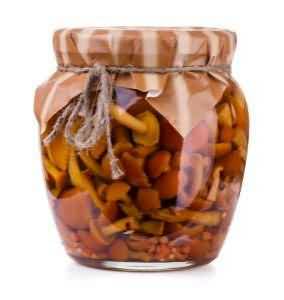 Mushroom Pickle
Mushroom Pickle
7. Mushroom candy:-
- Mushroom are impregnated and coated with sugar, subsequently taken out and dried is called a candied mushroom.
- The process for making candyis practically the same as that employed in the case of mushroom preserve (murabba)with the difference that the produce is impregnated with a higher concentration of sugar.
- The total sugar content of the impregnated produce is kept at about 75 percent to prevent fermentation.
- As soon as these become crispy, all mushrooms are taken out, packed in polypropylene bags and sealed.
- The mushroom candy can be stored up to 8 months with excellent acceptability and good chewable taste.
Conclusion
Mushrooms are easily grown and is a good enterprise for unemployed rural youths & farmers. The skill in mushroom cultivation is important to acquire before starting mushroom production.
Mushrooms are sold in most of the local market without standard packaging & measurement, unspecified quantities, qualities and the price variation. Hence there is a need to improve the value chain system and increase value addition.
Awareness about various uses and value added products need to be given for increasing the production and consumption of mushrooms as it is nutritious, medicinal and functional food.
Authors
Saraswati Pandey1 and Manish Prajapati2
1Dept. of Vegetable Science, College of Agriculture, IGKV, Raipur (C.G.) 492012
2Dept. of Horticulture, Post-Harvest Technology, Agriculture department, Balrampur, Chhattisgarh. 497119.
Email:
